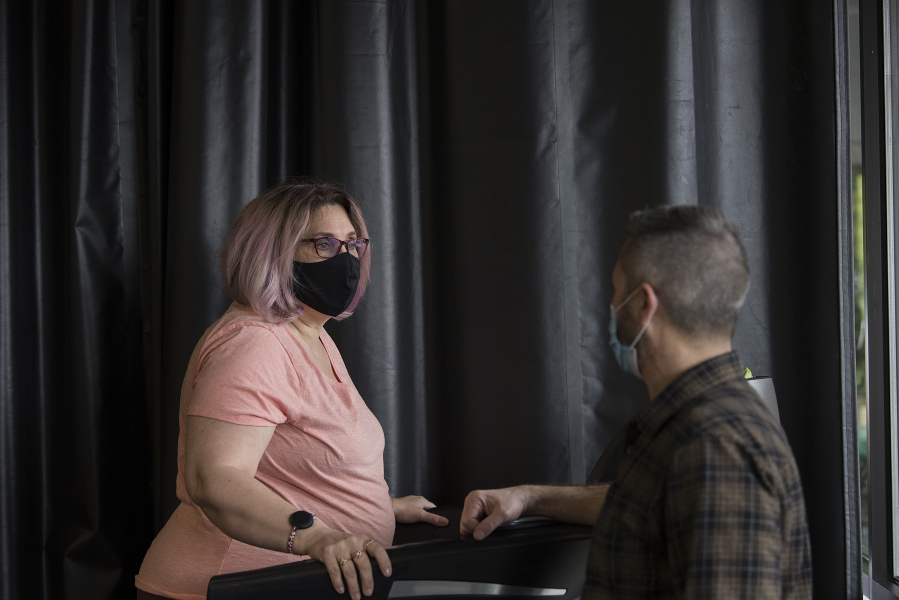Juli Fisher’s life is reflected in her before-and-after photos.
Such photos are a staple of the health and beauty world. Some people take them before cutting their hair. Others chronicle weight loss. But Fisher’s photos reflect how her life changed after she contracted COVID-19 a year ago.
Fisher’s before-COVID-19 photo shows three medications she took to treat high blood pressure and a thyroid disorder. The after photo shows roughly two dozen medications Fisher now regularly takes for problems with breathing, sleeping, gut health, muscle pain, depression and post-traumatic stress disorder, inflammation, energy, cellular repair, heart health, nasal congestion, acid reflux and coagulation.
Those are all chronic COVID-19 symptoms Fisher still has a year after the virus has technically come and gone.
“I’m trying anything and everything to get better,” she said.
An unfortunate trip
In late March 2020, Fisher went to the East Coast to work as a traveling nurse, hoping to help a senior care facility during the infancy of the COVID-19 pandemic.
When Fisher left, the care facility at which she was going to work had no cases. Upon arrival in Connecticut, Fisher learned the care facility had accrued two COVID-19 cases. When she showed up for work, the case count had risen to 15.
The outbreak continued to escalate. Ten days into her planned eight-week stay, Fisher began to feel sick. She later tested positive for COVID-19 and had to isolate herself in a hotel room. Her oxygen levels dropped so low that she moved to a hospital room for five days.
It wasn’t until May 22, weeks after her arrival, that Fisher was able to fly home to Vancouver and reunite with family.
For some people, that may be where the story ends – happily. That was not the case for Fisher. After returning, she continued to struggle with coronavirus symptoms, which she detailed in a late-July Columbian story.
Fisher, who is 52, slept with an oxygen concentrator and used an oxygen tank during the day when moving around.
She visited the emergency room over the summer, and at one point fell into a deep depression. She has cycled through different treatments, visiting a physical therapist, chiropractor and acupuncturist.
Her headaches have gone away, but she still struggles with breathing and coughs frequently. Fisher said doctors have told her she is getting enough oxygen into her lungs, but scar tissue is preventing the oxygen from transferring to her blood vessels.
Her rib cage hurts constantly, and she frequently experiences muscle cramps because of her breathing and coughing issues.
Fisher underwent a treatment with hyperbaric oxygen, which helped her a lot but was too expensive to continue in the long term.
Her recovery has been slow. In the last few months, Fisher has gone from being able to walk 1 minute and 36 seconds on a treadmill to 8 minutes.
“It’s just crazy how long it’s taking for me to get better,” Fisher said. “I make tiny improvements, and then I go backwards if I push myself too much. It’s this crazy cycle. It’s frustrating it has been so long.”
Emotional, financial toll
Because Fisher contracted COVID-19 in Connecticut, it was harder to get worker’s compensation to pay for her treatments back home. She hired a lawyer to help her navigate the worker’s compensation system, and expenses have piled up.
Fisher spends much of her worker’s compensation money on her medical treatments, leaving little money for other expenses.
Her family sometimes has had to hold off on paying rent to get by.
“I think I have like $3 in my bank account,” Fisher said in early March.
Because she can’t exercise, Fisher is also gaining weight, which she said isn’t helping her health. She has often felt powerless and depressed.
“There’s a little bit of despair in the back of the brain: ‘Is this what my life is like? Am I going to be this way forever?'” Fisher said. “I don’t know the answers. Nobody does. That’s hard – to not have the answers.”
Staying hopeful
One thing that gives Fisher hope is that the medical community is beginning to ramp up research around “long-haulers” like herself.
The federal government has given an official name to long-haulers’ disorder: “post-acute sequelae of COVID-19.” The National Institutes of Health also announced in February that it is jump-starting a $1 billion, four-year plan to research why people experience prolonged COVID-19 symptoms.
Oregon Health & Science University has also launched a Long COVID- 19 Program to get comprehensive, coordinated care to those with chronic COVID-19 symptoms.
Fisher is hopeful these advancements will help her in the future.
“I have to keep trying. Otherwise, I’ll go to a dark place,” Fisher said. “I just have to get up every day and be positive for today.”




